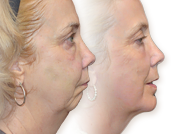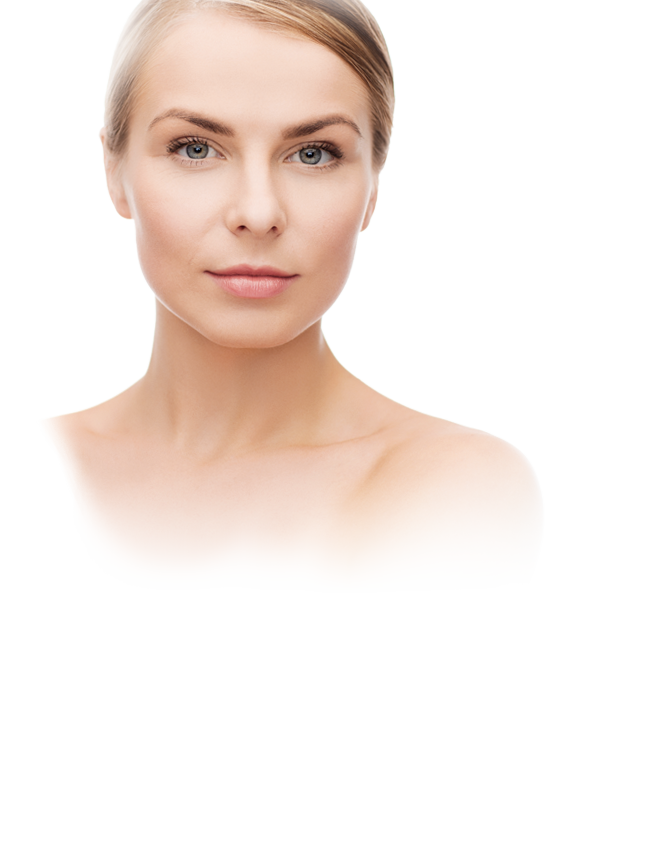What is Facelift Surgery?
Facelift surgery, also known as rhytidectomy, lifts and firms sagging facial tissues to restore a more naturally youthful facial appearance. It is often said that having a facelift works to “turn back the clock,” helping a patient look like a younger version of him or herself. By removing excess, sagging skin, smoothing deep folds, and lifting and tightening the deep facial tissues, rhytidectomy can help a patient look not just younger, but simply “better.”

Why Consider a Facelift?
As we age, skin begins to lose elasticity, and facial tissues lose volume. Eventually, this results in “jowls” on the lower face, deep wrinkles, and loose skin on the neck. While this is a natural part of growing older, patients who are bothered by these signs of aging may find a facelift to be a good solution. If any of the following describe you, rhytidectomy an option to consider:
- You feel self-conscious about the way your face & neck look due to sagging skin
- You wear turtlenecks and scarves not because you want to, but because you want to hide your aging neck
- When you see your reflection, you feel that your face makes you look much older than you feel
- You feel that an aging appearance is negatively affecting your career or personal relationships
Following a face-lift, patients frequently experience an upsurge in self-confidence, as their appearance better portrays their healthy, energetic vibe.
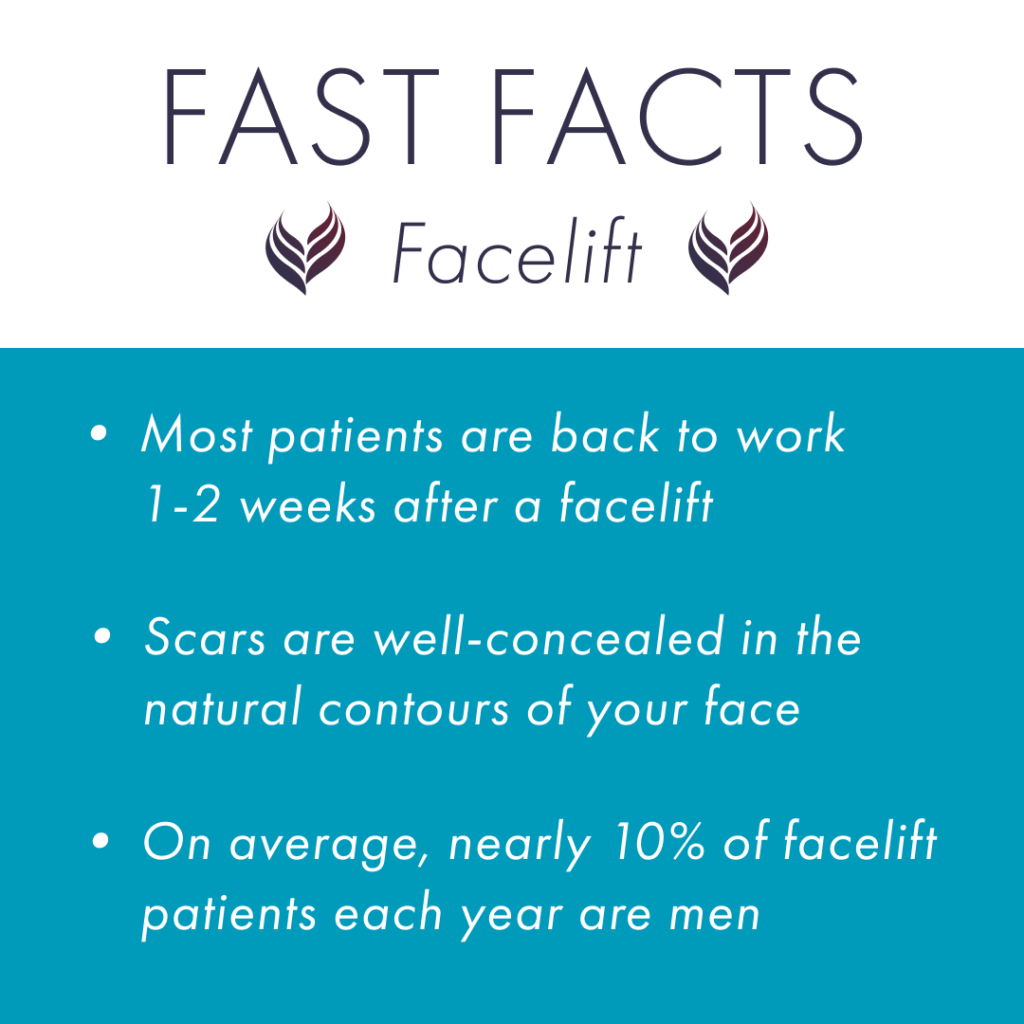

Choosing a Cosmetic Surgeon
Rhytidectomy is a complex procedure that requires extensive knowledge in facial anatomy, a very specific skill set of surgical techniques, and a highly-developed eye for aesthetic detail. Not all physicians who practice cosmetic surgery receive training in facelift surgery in their residency training, so it’s important to do your homework before choosing a facelift surgeon.
When consulting with potential cosmetic surgeons, discuss their specific training and experience in facial cosmetic surgery. Also, find out how many facelift surgeries each has performed, and be sure to look at plenty of before and after photos during your consultation—this will help you get a feel for a cosmetic surgeon’s aesthetic style. Men considering facelift surgery should make sure a cosmetic surgeon has experience performing facelifts for male patients; the anatomy of the male face is unique from a woman’s and requires a knowledgeable approach.
Prioritize Patient Safety
Choosing a board certified cosmetic surgeon ensures that your surgeon is specifically trained and experienced in cosmetic surgery, including rhytidectomy techniques, and that your procedure will be performed in an accredited surgical facility. Get helpful tips on choosing a cosmetic surgeon.
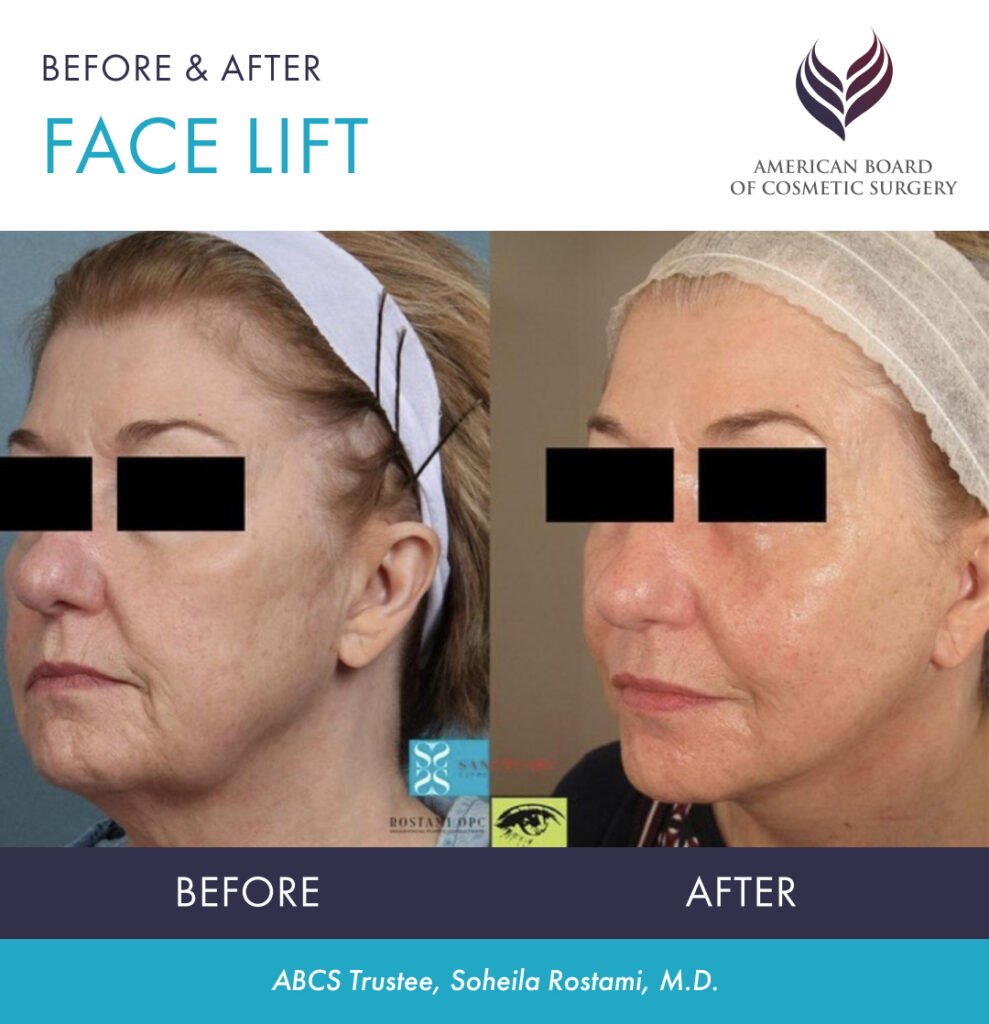
Look at their Results
Finally, look at before and after photos, paying special attention to the results of patients whose faces look similar to yours before surgery—this will help you get an idea for that surgeon’s aesthetic sensibility.
» SEARCH FOR AN ABCS COSMETIC SURGEON
In this video, ABCS diplomate Dr. Alex Sobel discusses how facelift surgery has and continues to improve over time, enhancing techniques and therefore results for patients.
Types of Facelifts
Facelift surgery is individualized to a patient’s needs, and a cosmetic surgeon will tailor their techniques accordingly.
Mini-Facelift
Patients who exhibit a mild degree of jowling and sagging skin are often good candidates for a mini-facelift. This is a less invasive technique that allows a cosmetic surgeon to tighten deep facial tissues through shorter incisions, typically located along the hairline above each ear and/or in the natural creases surrounding the ear. Through these incisions, structural tissues around the cheeks are lifted and tightened to correct jowling, refine the jawline, and rejuvenate a “tired” appearance.
Depending on the case, a mini-facelift may be performed using local anesthesia with sedation or general anesthesia; your cosmetic surgeon will recommend the best option for your individual needs. A mini-facelift can help you address unwelcome signs of aging before they become too pronounced, postponing the need for more extensive surgery for many years.
Standard Facelift
A standard or traditional facelift, also known as the superficial musculoaponeurotic system (SMAS) technique, will more fully address moderate to advanced aging around the mid-face and neck. While the surgery is more extensive than those for a mini-facelift, and thus more recovery time is required, the results are more dramatic. Through incisions located just behind the hairline, starting near the temples and around the front of the ear, hidden in the natural folds, a cosmetic surgeon can reposition the deeper tissues beneath the skin and remove excess skin to smooth creases, eliminate jowling and sagging skin under the chin, and restore a naturally youthful contour to the face and neck.
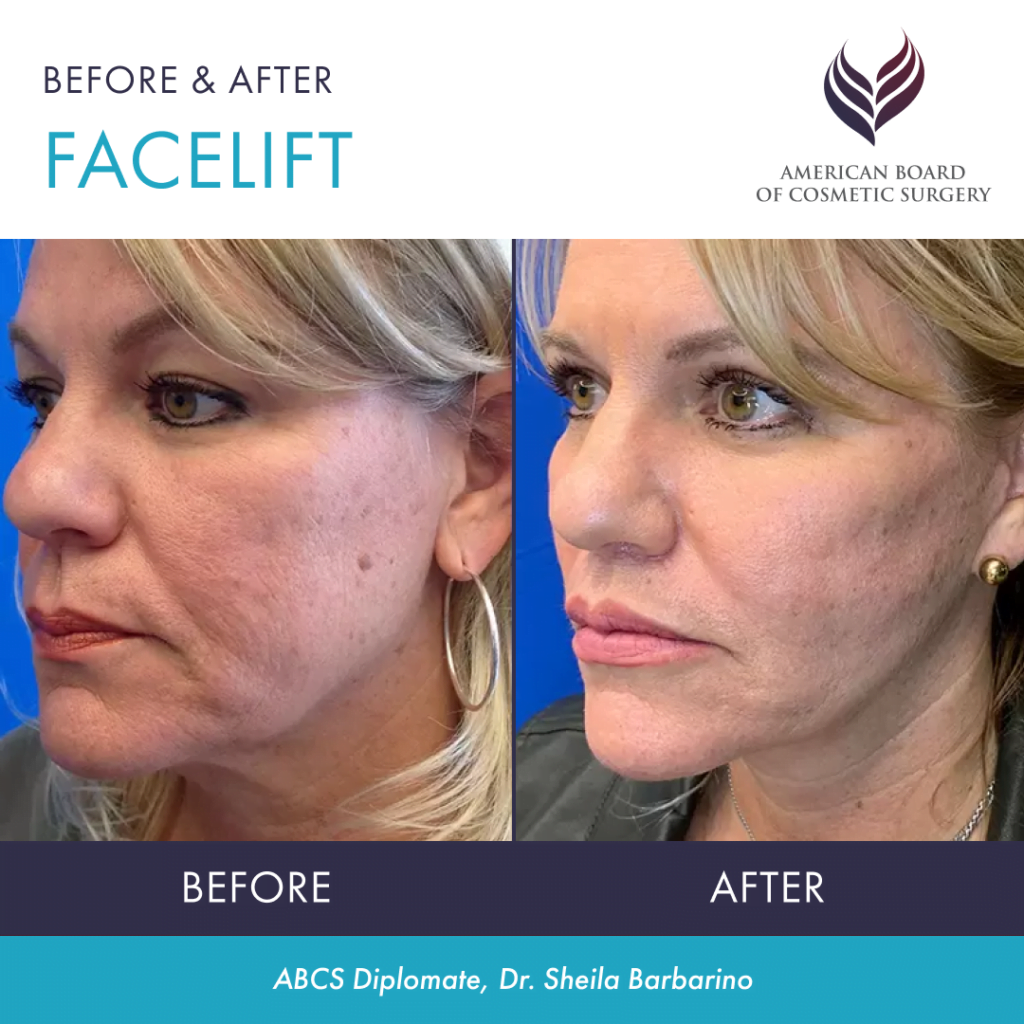
Deep Plane Facelift
During a deep plane facelift, a surgeon will reposition deeper tissues and structures of the face, including the muscles. This allows the surgeon to achieve more thorough lifting without tightly pulling the skin, thus achieving maximum results while retaining a natural-looking appearance. Deep plane facelift surgeons may also reposition fat pads in the cheeks, creating the appearance of a more lifted mid-face area. Deep plane facelifts are believed to provide longer-lasting results than the traditional SMAS method.
To learn more about the benefits of this modern facelift technique, read our blog in which a few ABCS surgeons discuss why they prefer deep plane facelifts.
What Happens During a Facelift?
The exact technique a cosmetic surgeon uses during rhytidectomy depends on a number of factors, including a patient’s anatomy and personal goals, the extent of the facelift (mini vs. standard), and whether or not another procedure is being performed at the same time. Facelifts are typically performed using general anesthesia, although local anesthesia with sedation may be used in certain less extensive procedures.
After making the initial incisions, the skin is separated from the underlying connective tissue and muscles. This allows the cosmetic surgeon to reposition the deeper facial tissues, get rid of the jowls and create a firmer foundation for the skin. Then, excess skin is removed, and the remaining skin is gently laid back over the newly rejuvenated facial tissues, giving the face a smoother, more youthful contour without over-tightening the skin.
In this video, ABCS diplomate Dr. J. Kevin Duplechain discusses his preferences for facelift incision placement so that others can’t tell you’ve had surgery done.
Can a Facelift Improve My Eyelids Too?
It’s not uncommon to hear the word “facelift” used when referring to any type of facial rejuvenation surgery, and understandably, a lot of people think that a facelift involves operating on the entire face—eyes, brow, cheeks and chin. That’s understandable; after all, your eyes and forehead are part of your face too. However, a facelift on its own only addresses the lower two thirds of the face – the cheeks and jawline.
Why is this the case? It is largely due to differences in anatomy. The skin, muscles and other tissues along the brow and surrounding the eyelids are very distinct, and cosmetic surgery to each of these areas requires an entirely different set of techniques than those used during a facelift.
It is common for patients to choose to have an eyelid lift, brow lift or neck contouring at the same time as a facelift, but in these cases, a cosmetic surgeon will actually be performing two different procedures in one single operation. Likewise, patients who only want to address aging around the eyes or neck can typically achieve their goals with only an eyelid lift or neck lift, and not a facelift.
- Key Benefits
- Glossary
- Reduces wrinkles: Facelift surgery can help to reduce the appearance of wrinkles and fine lines on the face, particularly around the mouth, jawline, and neck.
- Improves facial contours: A facelift can also improve the overall contour and definition of the face, particularly in the cheeks and jawline.
- Restores youthful appearance: By reducing the signs of aging and smoothing the complexion, a facelift can “turn back the clock” several years.
- Rhytidectomy: A surgical procedure to reduce signs of aging by tightening the skin and underlying tissues of the face and neck.
- General anesthesia: A state of controlled unconsciousness induced by medications to eliminate pain during surgery.
- Brow lift: A surgical procedure that raises and tightens the tissues of the forehead and eyebrows to reduce sagging and wrinkles.
- Local anesthesia: Administration of medication to numb a specific area of the body, typically used for minor procedures and surgeries.
- SMAS lift: A common facelift technique that involves repositioning and tightening the superficial musculoaponeurotic system (SMAS) layer of the face for improved facial contouring.
- Deep plane facelift: A surgical technique that addresses deeper layers of facial tissue, ligaments, and muscles to provide facial rejuvenation.
- Hematoma: A collection of blood that forms outside of blood vessels, often resulting from injury or surgery.
- Neck lift (platysmaplasty): A surgical procedure to improve the appearance of the neck by tightening the muscles and removing excess skin and fat.
- Eyelid lift (blepharoplasty): A surgical procedure to remove excess skin and fat from the eyelids.
- Fat transfer: A procedure that involves removing fat from one area of the body via liposuction and injecting it beneath the skin in another area, commonly used in facial rejuvenation for augmentation or volume restoration.
- Dermabrasion: A technique that uses a rotating instrument to remove the outer layers of skin, typically used to improve the appearance of scars, wrinkles, and skin irregularities.
- Laser skin resurfacing: A cosmetic procedure that uses laser technology to remove damaged skin and stimulate the growth of new, healthier collagen and elastin, resulting in improved skin texture and appearance.
- Collagen: The structural, “scaffolding” protein that gives skin its strength and plumpness.
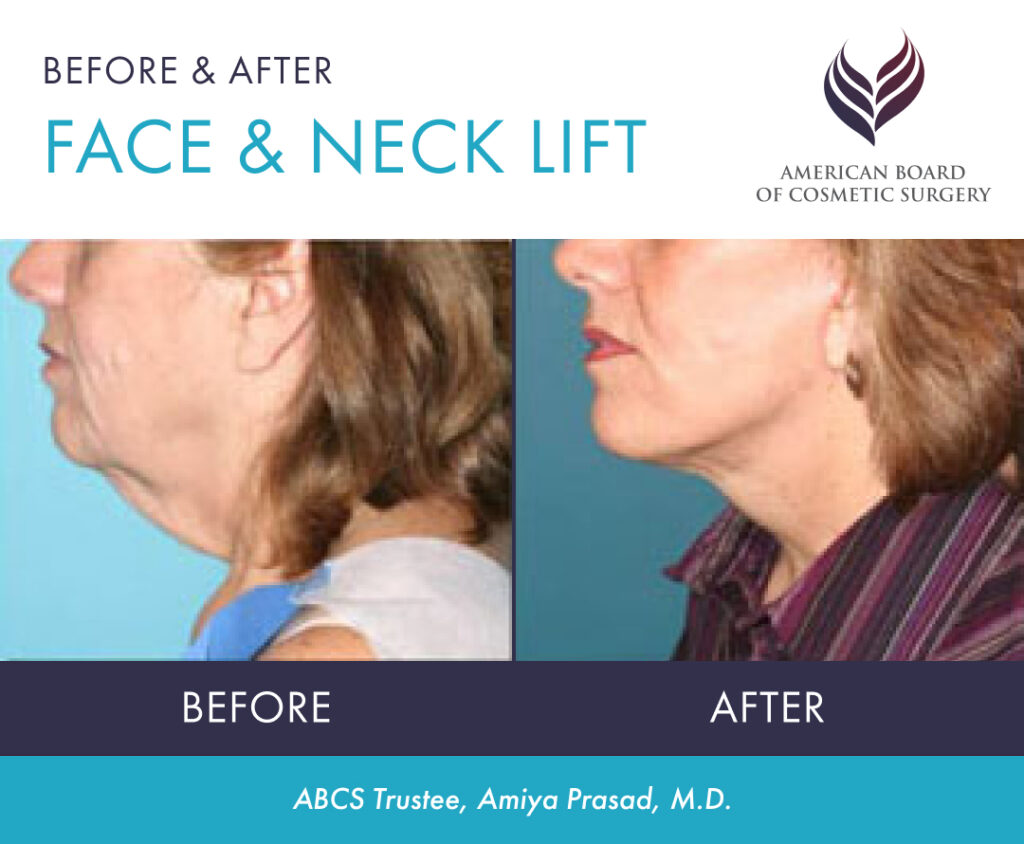
Life After a Facelift
A face-lift is a complex procedure requiring exceptional surgical skill, but the recovery process is surprisingly quick for most patients. Patients typically return to normal daily activities after about 2 weeks (strenuous exercise will need to wait about 4 weeks) following a standard facelift, and these time frames are normally even shorter after a mini facelift. As every patient heals a little differently, your cosmetic surgeon will give you detailed instructions for aftercare and returning to activity.
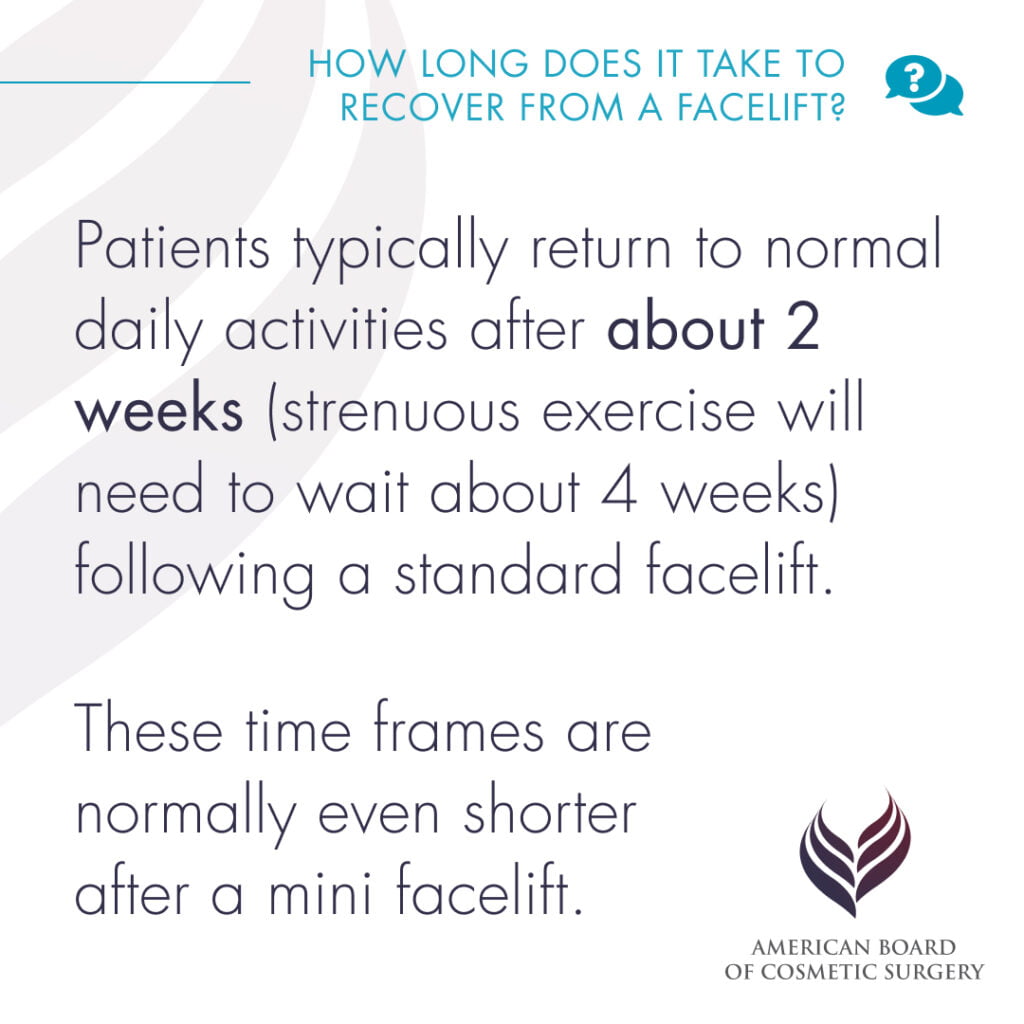
One of the primary concerns patients have following a facelift is how soon they will look presentable after their procedures, and understandably so–unlike a breast or body procedure, for example, you cannot easily cover the area with clothing. Bruising and swelling are normal after a facelift and will be at their peak about 2 days after surgery. After that, bruising and swelling will gradually get better and should be difficult to notice after about 10 to 14 days. Even so, many patients feel comfortable going out in public about a week or so after their procedures. Your cosmetic surgeon can advise you about when it is safe to wear camouflage makeup.
As you ease back into your routine after a facelift, it’s especially important to keep your face protected from the sun. You will be more vulnerable to sunburn for several weeks after surgery, plus staying out of the sun will help scars heal as inconspicuously as possible. Wear a wide-brimmed hat and apply sunscreen regularly.
In this video, ABCS diplomate Dr. Samir Pancholi discusses what to expect during facelift recovery and when you should be able to return to work.
Can I Have A Nonsurgical Facelift?
If you would like to avoid having a traditional surgical facelift—or if you’ve already had a facelift and are seeking a way to maintain your results—there are a number of helpful, minimally-invasive options to consider. While these non-surgical treatments can’t remove sagging skin or reposition tissues, they can effectively take years off your appearance via other means. And, because they also offer alternative benefits a surgical facelift can’t provide, they are a great way to enhance the procedure. Popular nonsurgical facelift options currently include:
- Laser skin resurfacing. Laser skin resurfacing can smooth fine lines and wrinkles; correct age spots, acne scars, and discoloration; and improve skin tone & quality. Laser treatments can either be ablative or non-ablative, depending on the depth of skin you wish to treat. There are a number of lasers that can be used to rejuvenate the face, which are covered here.
- Renuvion. Renuvion tightens lax skin and subdermal tissues using radiofrequency (RF) energy and helium plasma. The combination of RF and plasma allows your surgeon to precisely regulate Renuvion’s heating and cooling abilities, ensuring tissues are heated to the optimal temperature for contraction while maintaining patient safety & comfort. Plus, Renuvion’s RF energy stimulates collagen production deep within the skin for firmer, younger-looking skin. Renuvion can be applied to the brow, lower cheeks, jawline, neck, and eye area for full facial tightening.
- Forma. Forma by inMode utilizes radiofrequency (RF) energy to lift, tone, and smooth facial and neck skin by heating subdermal layers of tissue. Similar to Renuvion, this heat promotes collagen production within the dermis for healthier looking skin that improves over the months following treatment. Forma’s specialized electrode-emitting hand-piece allows clinicians to view patients’ skin temperature in real time and features a “cut-off” temperature for increased patient safety.
- Ultherapy. Ultherapy uses ultrasound energy to tighten deep layers of skin and underlying muscle in the face and neck. It works by initiating “neocollagenesis,” a process that triggers the body to regenerate collagen proteins for healthy new skin growth. Most patients see a noticeable difference in their skin quality 2 to 3 months after their Ultherapy treatment. Learn more about Ultherapy »
- RF microneedling. You’re likely familiar with the mechanics of microneedling by now—tiny needles are applied to superficial layers of skin to create “micro-injuries” which prompt the skin to heal itself. Radiofrequency (RF) microneedling takes microneedling a step further by applying RF energy to skin on the face and neck, heating the deep dermis to stimulate new collagen and elastin fiber growth deep within for visibly tighter, smoother skin that continues to improve over the months following your treatment. Popular RF microneedling brands include Morpheus8 and Genius. Learn more about microneedling »
- Dermal fillers. Injectable fillers remain one of the most popular nonsurgical options for facial rejuvenation, having helped patients turn back the hands of time for decades. Fillers are strategically injected under the skin to replace lost volume in the cheeks, temples, lips, under-eyes, and nasolabial folds, and to enhance facial symmetry. A skilled provider will use different fillers to enhance different areas of the face. For instance, Sculptra Aesthetic stimulates collagen production to gradually restore facial fullness and erase deep wrinkles and folds for up to 2 years; Juvéderm Voluma is ideal for lifting the cheeks and adding volume to the mid-face; and Juvéderm Vollure is a favorite for filling in unwanted smile lines. Fillers can also be used to augment the chin to create a slimmer facial appearance and define the jawline, and even create temporary rhinoplasty results. Filler results typically last between 6 to 12 months, but Sculptra and Bellafill can last for 2+ years. Learn more about dermal fillers »
- Botox. When it comes to temporarily reducing the appearance of dynamic wrinkles (those caused by facial movements), Botox can’t be beat. Botox is injected into the face to smooth glabellar lines, horizontal forehead creases, frown lines, crow’s feet, and vertical lip lines. It can also be injected into the masseter muscle to make the jawline appear slimmer and more contoured. Botox is often paired with dermal filler injections for a full nonsurgical makeover. Results typically last 3 to 4 months. Learn more about Botox »
- Fat injection. For patients wanting long-lasting results, a skilled surgeon can harvest unwanted body fat from the abdomen, flanks, or thighs via liposuction and inject it into the cheeks, temples, or under-eyes to restore volume in the face. Fat injection (or fat transfer) provides semi-permanent results that can last for many years, making it the ideal procedure for patients who want to avoid facelift surgery but desire a more permanent result than dermal fillers can provide. Learn more about fat injection »
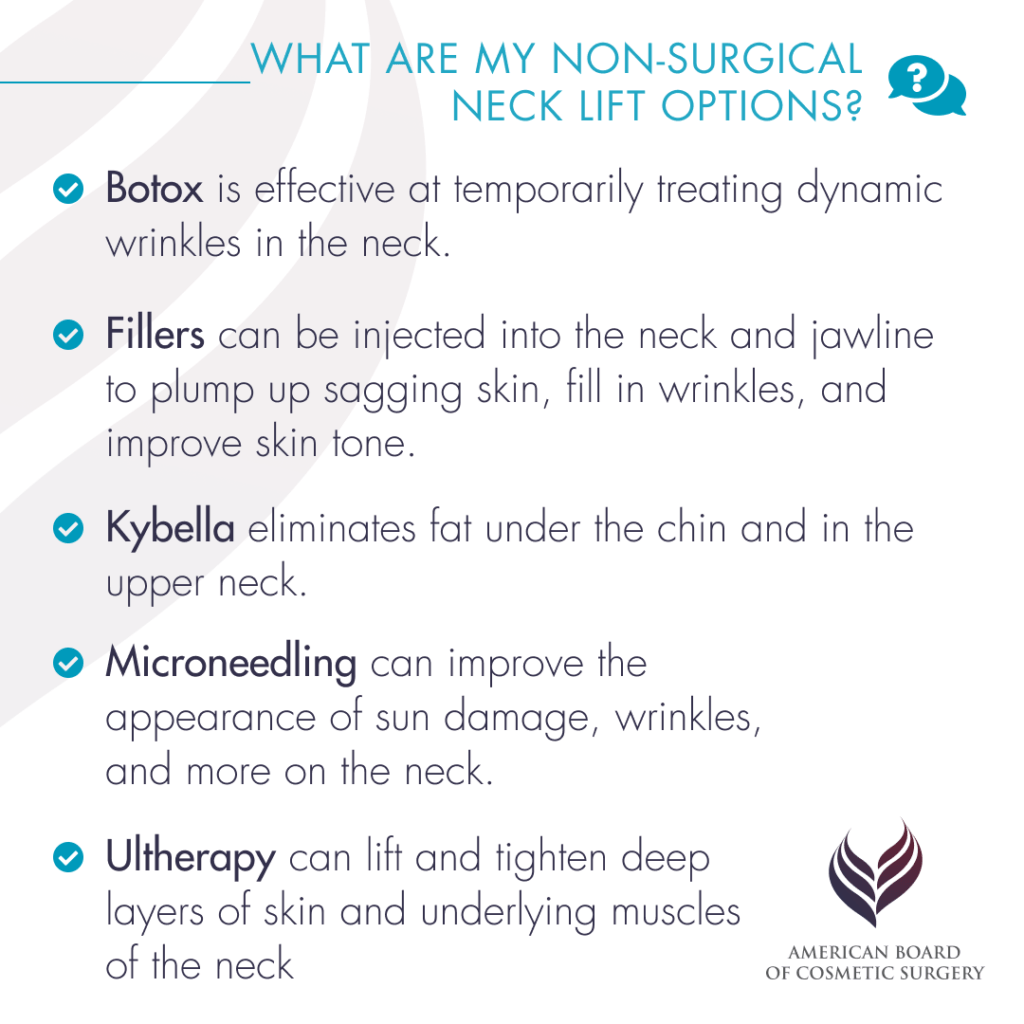
Many of these procedures can be combined with one another or with various facial cosmetic surgeries, such as eyelid lift or brow lift surgery, for optimal tissue tightening and skin rejuvenation.
How Will Facelift Results Look Over the Long Term?
When performed by an experienced, board certified cosmetic surgeon, a facelift is designed to achieve results that not only look natural now, but will also age naturally with you. While nothing can stop the normal aging process, after a facelift you should always look years younger than you would have without the surgery.
However, there are certain things you can do to keep your results looking their best. Maintaining a healthy, stable weight is important as significant weight fluctuations can cause skin to stretch out again. You should also adopt a consistent, quality skin care regimen to keep your skin healthy and protected from unnecessary aging.
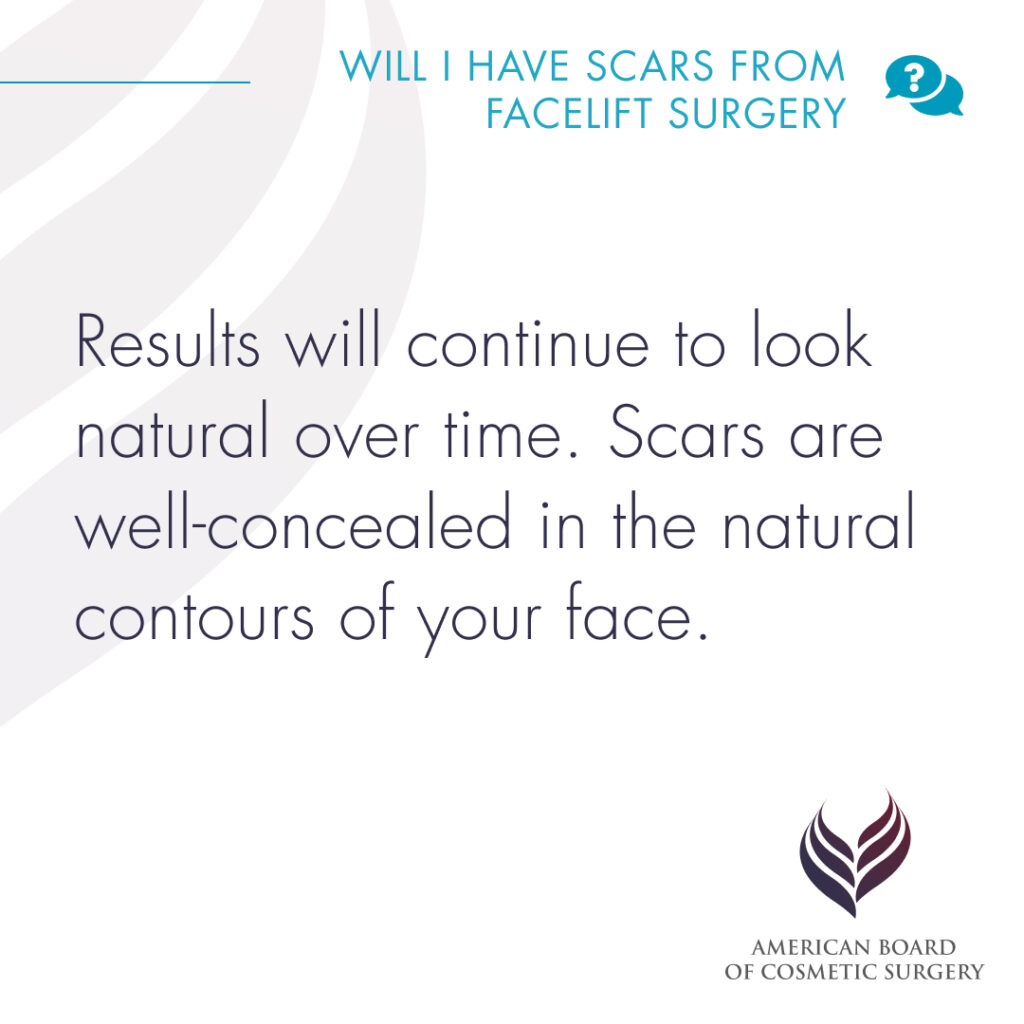
When performed by a qualified cosmetic surgeon, rhytidectomy is a safe procedure and an excellent way to rejuvenate your appearance. The best way to decide if a facelift is right for you is to consult with a board certified cosmetic surgeon. You can use our ABCS Find-a-Surgeon tool to find cosmetic surgeons in your area.
References »
Moyer JS, Baker SR. Complications of rhytidectomy. Facial Plastic Surgery Clinics of North America. 2005. doi: 10.1016/j.fsc.2005.04.005.
Mittelman H, Hershcovitch M. Management of the midface during rhytidectomy. Facial Plastic Surgery Clinics of North America. 2015. doi: 10.1016/j.fsc.2015.01.005.
Rousso DE, Adams AS. Nuances in Superficial Musculoaponeurotic System Rhytidectomy. Facial Plastic Surgery Clinics of North America. 2020. doi: 10.1016/j.fsc.2020.03.010.
Jacono AA. A Novel Volumizing Extended Deep-Plane Facelift: Using Composite Flap Shifts to Volumize the Midface and Jawline. Facial Plastic Surgery Clinics of North America. 2020. doi: 10.1016/j.fsc.2020.03.001.
Jacono A, Bryant LM. Extended Deep Plane Facelift: Incorporating Facial Retaining Ligament Release and Composite Flap Shifts to Maximize Midface, Jawline and Neck Rejuvenation. Clinics in Plastic Surgery. 2018. doi: 10.1016/j.cps.2018.06.007.
Bater KL, Ishii LE, Papel ID, Kontis TC, Byrne PJ, Boahene KDO, Nellis JC, Ishii M. Association Between Facial Rejuvenation and Observer Ratings of Youth, Attractiveness, Success, and Health. Facial Plastic Surgery & Aesthetic Medicine. 2017. doi: 10.1001/jamafacial.2017.0126.
